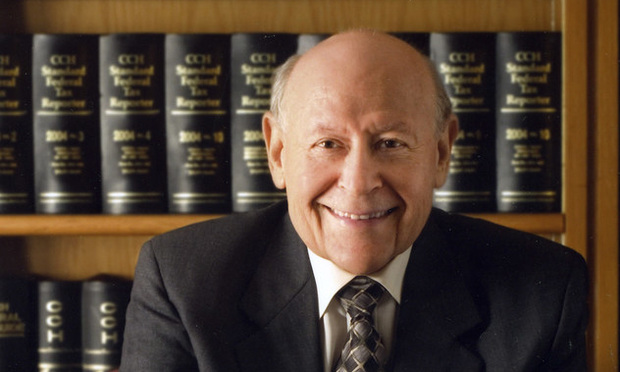Sideline Activities: The Good and the Bad
In his Tax Tips column, Sidney Kess discusses the tax treatment of activities that people may conduct in addition to their main line of work. Some of these sideline activities may be profitable ventures while others run in the red. From a tax perspective, the treatment of income and losses can be good or bad; it all depends.
May 17, 2019 at 12:45 PM
6 minute read
 Sidney Kess
Sidney Kess
Attorneys, accountants, and many other individuals may conduct activities in addition to their main line of work. These activities may be chartering boats, breeding dogs, selling antiques, or any other manner of business. Some of these sideline activities may be profitable ventures while others run in the red. From a tax perspective, the treatment of income and losses can be good or bad; it all depends.
Profitable Sideline Activities
If a sideline activity generates income after subtracting deductible expenses, the income is taxed in the same way as any other business income; it's ordinary income. Usually, sideline activities are conducted as sole proprietorships, so income and expenses are reported on Schedule C of Form 1040. But there is nothing that prevents a sideline activity from being run through a corporation or limited liability company.
Taxable income can effectively be reduced by contributing to a qualified retirement plan based on profits from the sideline activity. An individual covered by another qualified retirement plan (e.g., one through a legal practice) may still be eligible to receive contributions with respect to the sideline activity. However, contributions limits (e.g., annual cap on elective contributions to 401(k) plans) apply.
Profits from a sideline activity are taken into account in figuring the 20% qualified business income (QBI) deduction to the same extent as a full-time business (Code §199A). Thus, income from a sideline activity increases taxable income, which may limit or bar any QBI deduction for a main activity if that main activity is a specified service trade or business (SSTB). Those providing services through a pass-through entity (e.g., a limited liability partnership) for the practice of law, accounting, or certain other enumerated activities (Code §199A(d)(2)) are in an SSTB and the QBI deduction for this pass-through income phases out or is barred when taxable income exceeds applicable limits. In 2019, no QBI deduction can be claimed if taxable income exceeds $421,400 on a joint return, $210,700 for singles and heads of households, and $210,725 for married persons filing separately (Rev. Proc. 2018-57). With respect to the sideline activity, a QBI deduction for someone with taxable income over the initial threshold amount is limited (in 2019, $321,400 on joint returns, $160,700 for singles and heads of households, and $160,725 for married persons filing separately), is based in part on W-2 wages (of which there may be none in a sideline activity) and the unadjusted basis of property immediately after acquisition (UBIA). Final regulations clarify the computation of the QBI deduction (T.D. 9847, Feb. 8, 2019).
Unprofitable Sideline Activities
Unfortunately, a sideline activity may not be profitable. When this happens, the IRS may challenge whether a taxpayer has a profit motive in conducting the activity. If a taxpayer lacks of a profit motive, then the hobby loss rules apply (Code §183). This means that all income from the activity is taxable, while no deductions are allowed in 2018 through 2025 (the period in which the write-off for miscellaneous itemized deductions subject to the 2% of adjusted gross income floor is suspended). These deductions cannot be carried forward; they are lost forever.
There are nine factors used by the IRS and courts to assess whether an activity is a hobby or a business (Code §1.183-2(b)):
(1) The manner in which the taxpayer carries on the activity
(2) The expertise of the taxpayer and his/her advisors
(3) The time and effort expended by the taxpayer in carrying on the activity
(4) The expectation that assets used in the activity may appreciate in value
(5) The success of the taxpayer in carrying on other similar or dissimilar activities
(6) The taxpayer's history of income or losses with respect to the activity
(7) The amount of occasional profit, if any, which is earned
(8) The financial status of the taxpayer
(9) The elements of personal pleasure or recreation
The IRS has an Audit Technique Guide (ATG) explaining these nine factors in greater detail and advising agents what to look for in making a hobby determination. No single factor is controlling.
Recent Examples of Hobby Activities
The issue of hobby losses gives rise to considerable litigation. Here are examples of two recent cases on point.
Plane restoration. A former naval officer and commercial airline pilot restored a Fairey Firefly, a British plane used during World War II and through the 1960s. He spent considerable money doing this and expected to earn a return through air shows and leasing activities (potentially with the U.S. government). But he never actually earned much. The Tax Court held that this was a hobby activity (Kurdziel, Jr., TC Memo 2019-20). He didn't run this activity like a business; there was no business plan or separate books and records. He used the plane to promote another one of his businesses (a flight training school), but profits from the Fairey Firefly were merely hopes and dreams.
Yacht charter operations. A couple (the husband was a highly successful CPA) bought a $4.6 million yacht and spent another $10 million refitting it for a round-the-world trip. But health issues and financial concerns ended thoughts of a trip. Instead, the couple wanted to use the yacht for charter through two charter brokerage companies. There was considerable advertising, but only one charter of $150,000. All the while, the couple used the boat for diving and other personal activities. The Tax Court held that this was a hobby activity (Steiner, TC Memo 2019-25). While there was a business bank account, the couple paid most of the expenses (e.g., a full-time crew) from their personal bank accounts or with their personal credit cards. This was an activity for their personal pleasure and recreation and not primarily to make a profit.
Conclusion
When a sideline activity is profitable, consider its impact on the QBI deduction. When it comes to a sideline activity viewed as a hobby, there is no tax advantage. Thus, anyone engaged in a sideline activity should be sure to review the nine factors and conduct the activity in such a way as to demonstrate a profit motive. That way, if there are losses, they may still be deductible.
Sidney Kess, CPA-attorney, is of counsel at Kostelanetz & Fink and senior consultant to Citrin Cooperman & Company.
This content has been archived. It is available through our partners, LexisNexis® and Bloomberg Law.
To view this content, please continue to their sites.
Not a Lexis Subscriber?
Subscribe Now
Not a Bloomberg Law Subscriber?
Subscribe Now
NOT FOR REPRINT
© 2025 ALM Global, LLC, All Rights Reserved. Request academic re-use from www.copyright.com. All other uses, submit a request to [email protected]. For more information visit Asset & Logo Licensing.
You Might Like
View All
Big Law Sidelined as Asian IPOs in New York Are Dominated by Small Cap Listings

The Benefits of E-Filing for Affordable, Effortless and Equal Access to Justice
7 minute read
A Primer on Using Third-Party Depositions To Prove Your Case at Trial
13 minute read
Shifting Sands: May a Court Properly Order the Sale of the Marital Residence During a Divorce’s Pendency?
9 minute readTrending Stories
- 1No Two Wildfires Alike: Lawyers Take Different Legal Strategies in California
- 2Poop-Themed Dog Toy OK as Parody, but Still Tarnished Jack Daniel’s Brand, Court Says
- 3Meet the New President of NY's Association of Trial Court Jurists
- 4Lawyers' Phones Are Ringing: What Should Employers Do If ICE Raids Their Business?
- 5Freshfields Hires Ex-SEC Corporate Finance Director in Silicon Valley
Who Got The Work
J. Brugh Lower of Gibbons has entered an appearance for industrial equipment supplier Devco Corporation in a pending trademark infringement lawsuit. The suit, accusing the defendant of selling knock-off Graco products, was filed Dec. 18 in New Jersey District Court by Rivkin Radler on behalf of Graco Inc. and Graco Minnesota. The case, assigned to U.S. District Judge Zahid N. Quraishi, is 3:24-cv-11294, Graco Inc. et al v. Devco Corporation.
Who Got The Work
Rebecca Maller-Stein and Kent A. Yalowitz of Arnold & Porter Kaye Scholer have entered their appearances for Hanaco Venture Capital and its executives, Lior Prosor and David Frankel, in a pending securities lawsuit. The action, filed on Dec. 24 in New York Southern District Court by Zell, Aron & Co. on behalf of Goldeneye Advisors, accuses the defendants of negligently and fraudulently managing the plaintiff's $1 million investment. The case, assigned to U.S. District Judge Vernon S. Broderick, is 1:24-cv-09918, Goldeneye Advisors, LLC v. Hanaco Venture Capital, Ltd. et al.
Who Got The Work
Attorneys from A&O Shearman has stepped in as defense counsel for Toronto-Dominion Bank and other defendants in a pending securities class action. The suit, filed Dec. 11 in New York Southern District Court by Bleichmar Fonti & Auld, accuses the defendants of concealing the bank's 'pervasive' deficiencies in regards to its compliance with the Bank Secrecy Act and the quality of its anti-money laundering controls. The case, assigned to U.S. District Judge Arun Subramanian, is 1:24-cv-09445, Gonzalez v. The Toronto-Dominion Bank et al.
Who Got The Work
Crown Castle International, a Pennsylvania company providing shared communications infrastructure, has turned to Luke D. Wolf of Gordon Rees Scully Mansukhani to fend off a pending breach-of-contract lawsuit. The court action, filed Nov. 25 in Michigan Eastern District Court by Hooper Hathaway PC on behalf of The Town Residences LLC, accuses Crown Castle of failing to transfer approximately $30,000 in utility payments from T-Mobile in breach of a roof-top lease and assignment agreement. The case, assigned to U.S. District Judge Susan K. Declercq, is 2:24-cv-13131, The Town Residences LLC v. T-Mobile US, Inc. et al.
Who Got The Work
Wilfred P. Coronato and Daniel M. Schwartz of McCarter & English have stepped in as defense counsel to Electrolux Home Products Inc. in a pending product liability lawsuit. The court action, filed Nov. 26 in New York Eastern District Court by Poulos Lopiccolo PC and Nagel Rice LLP on behalf of David Stern, alleges that the defendant's refrigerators’ drawers and shelving repeatedly break and fall apart within months after purchase. The case, assigned to U.S. District Judge Joan M. Azrack, is 2:24-cv-08204, Stern v. Electrolux Home Products, Inc.
Featured Firms
Law Offices of Gary Martin Hays & Associates, P.C.
(470) 294-1674
Law Offices of Mark E. Salomone
(857) 444-6468
Smith & Hassler
(713) 739-1250






